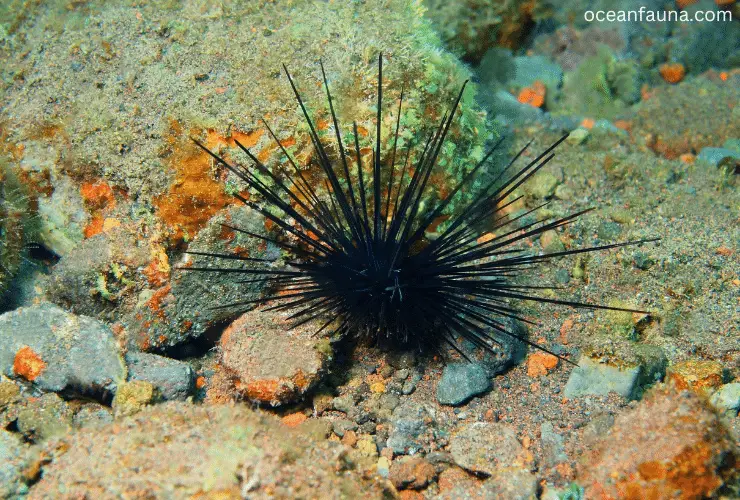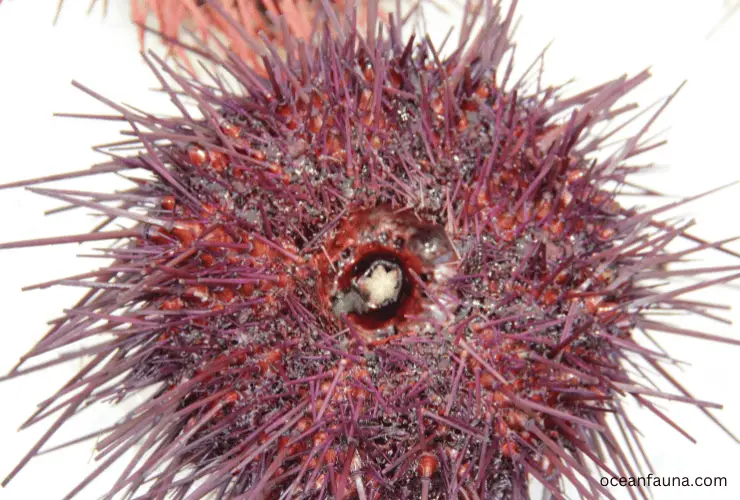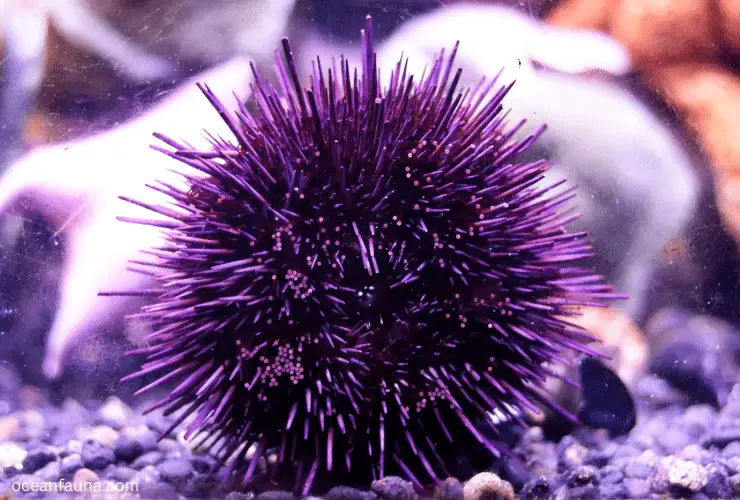No, sea urchins do not have eyes, but they have some special organs like the esophagus and intestine. Sea urchins, the closest living cousins of starfish, lack eyes. Instead of eyes, they use long, tube-like appendages on their feet to sense their environment.
It’s not the only thing the tentacles-like tube feet do; they may also act as a light sensor. Sea urchins use them for both eating and, in some species, walking about. When inverted, others can be attached to surfaces or used as levers to turn it right up.
This article is focused on every query related to the eyes and organs of a sea urchin. Every question related to the urchin’s sight or organs will be answered, along with some other interesting facts. Let’s immediately get into the details.
Do Sea Urchins Have Eyes?
Technically, sea urchins have no eyes. Their eyes are quite different from those of other animals. It means they don’t have eyes, but they have some tentacle-like tubes that work like eyes.
They have a light-sensing organ that is not even related to the eyes in the family of fish. So what are they? It is called a rhabdomeric organ and resembles a smaller, hair-like tube.
It sends electrical impulses to the brain that are interpreted as images of the environment. Since it doesn’t have a lens, it sends waves through the body which are processed to form pictures.

According to research undertaken as part of John Kirwan’s Ph.D. thesis at Lund University, “Only Sea urchins have been proven to have some form of visual perception independent of eye structure. Their tube feet, which look like tentacles and are dispersed throughout the body like the spines, contain light-sensitive cells that allow them to see.”
He suggested that the entire sea urchin is actually just a single compound eye. Hence, it doesn’t look like an eye. The tube feet are also used to attach to the soil and feel for food. (Source)
It’s mind-boggling that an animal so tiny, globular, and simple-bodied, with no head, arms, or legs, could provide such a complex response to stimuli in its environment.
Also See: Do Sea Urchins Have Brains?
How Many Eyes Do Sea Urchin Have?
According to recent research shown on Live Science, sea urchins may use their entire bodies as a single set of eyes. They do not have eyes like other sea creatures. (Source)
Scientists are increasingly modeling robots after invertebrates like urchins rather than more traditional vertebrates like us because of the urchins’ streamlined approach to vision and cognition.
Are Sea Urchins Blind?
No, as we have discussed before, sea urchins do not have eyes, but they can see with their feet which act like one giant eye.
It shows they are not blind. This is something cool and one of the unique facts about this animal.
How Do Sea Urchins See?
National Geographic has already said that Urchins can “see” with their spines instead of eyes. In simple words, we can call them “Eyeless Urchins”. But how do they see with spines? Source
Sonke Johnsen and her colleagues at Duke University captured 20 Strongylocentrotus purpuratus sea urchins from the wild and examined their reactions to sets of black discs to learn more about the urchins’ visual capabilities.
Disks of two different sizes (2.3 inches (6 centimeters) and 3.9 inches (10 centimeters) in diameter) were provided to each urchin in a well-lit, otherwise empty tank. Separating the urchin by 20 inches (half a meter) between each disc.
They discovered that the sea urchins paid no attention to the smaller discs, as hypothesized by Johnsen’s team. However, when shown the larger discs, some of the urchins ran away while others scurried closer.
The researchers Johnsen and his team led don’t know why the urchins reacted differently to the larger discs. Still, they hypothesize that the herbivorous urchins didn’t know whether the black spots signaled a predator or food.
This pattern of behavior, however, hints that even spine-rich species, like S. purpuratus, have limited visual capabilities, according to the study’s authors.
Future research on other species may shed light on the correlation between urchin spine density and visual acuity. Sea urchins are also highly knowledgeable in knowing what’s what.
More interestingly, this finding also suggests that urchins’ visual abilities are comparable to those of marine invertebrates like the nautilus and the horseshoe crab, despite the urchins’ lack of eyes. It’s just another unique fact about sea urchins that are worth mentioning.
The pedicellariae and the tube feet of an adult sea urchin serve as the animal’s feet and hands, respectively. These minute structures, which aid in locomotion and feeding, are buried deep within the urchin’s dense network of spines.
In addition to their more obvious functions, these structures also have the ability to see in the dark by being sensitive to light.
Specifically, receptors called G-protein-coupled receptors (GPCR) are involved in this sensory activity, and they are found mostly at the pedicellariae’s and tube feet’s apex and base, respectively.
Urchins are able to “see” potential predators and find shelter from the sun when they are trapped in rock pools during the hot summer months because their entire bodies are covered in pedicellariae and tube feet. Intriguingly, the genes involved in sea urchin light sensitivity control eye development in all animals.
Sea urchins utilize more than just their eyes to detect danger. A sea urchin’s GPCRs also give them an acute sense of smell (chemosensory), allowing them to pick up on the chemical aroma that adjacent predators discharge into the water.
They have a keen sense of smell and can use it to detect the presence of predators by detecting the odor of injured urchins. Sea urchins use a similar process to detect food from a distance, and their chemosensory sense allows them to be extremely picky about what they eat.
When we uncover the mechanism of how sea urchins perceive their world and their vision improves, it will provide new insights into the mechanisms of other animal senses. It leads to an increased understanding of the general principles of perception and a better understanding of animal cognition.
What Is the Eyeball-Looking Thing On A Sea Urchin?
Some people mistake the red dot on a long-spined sea urchin for an eye, but it’s not. It’s a photoreceptor. This photoreceptor will allow it to perceive the world around it.
If you didn’t know, harmful algae would multiply rapidly without sea urchins to eat them. It is safe to say that no coral reefs would exist if urchins weren’t present.
Do Sea Urchins Have Glowing Eyes?
Sea urchins lack glowing eyes. However, their bodies glow when light shines on them from above. Don’t get worried about this. The fluorescence of their bodies comes from some symbiotic bacteria that live inside the sea urchin’s cells.

The bacteria contain pigments that glow when exposed to a certain wavelength of ultraviolet light, and it gives their body a reddish-blue color. This shows the entire body of the sea urchin is a glowing eye but does not have specific glowing eyes.
Do Sea Urchins Have Faces?
No, sea urchins do not have faces. They are covered in spines that are extremely elongated and pointed.
Even though sea urchins lack a distinguishable face, their mouth and anus are easy to identify.
Sea urchins, like sea stars, feature fivefold symmetry. The sea star’s five limbs make its symmetry visible, but the sea urchin isn’t.
Do Sea Urchins Have Organs?
Yeah, sea urchins have organs. If you cut open a sea urchin and look inside, you will notice that it has several organs that are similar to those found in other animals, such as an esophagus and an intestine.
Some components are unique to this animal and cannot be found in the majority of other animals. The organs that are a component of the water system that operates like a hydraulic pump are the ones that stand out as being the most distinctive.
Do Sea Urchins Have Legs?
Sea urchins have legs. And guess what they have hundreds of tiny eggs. It’s a fascinating and surprising fact about these interesting and unique creatures.
Urchins use their short spines present at the bottom of them for walking. They can also move and walk on their teeth and feet. They can move freely and easily on their spines.
Conclusion
Sea urchins can see colors, have elaborate sensory capabilities, perceive their surroundings, and have powerful chemosensory abilities.
Sea urchins are incredibly diverse sea creatures whose entire body looks and works like an eye. These animals are more than just small blobs – they are some of the most fascinating animals around, and understanding their visionary facts is fun.
As we learn more about their anatomy, we can expand our scope of knowledge and understanding of their diverse range of abilities. They are well worth our attention.


4 thoughts on “Do Sea Urchins Have Eyes or Special Organs?”